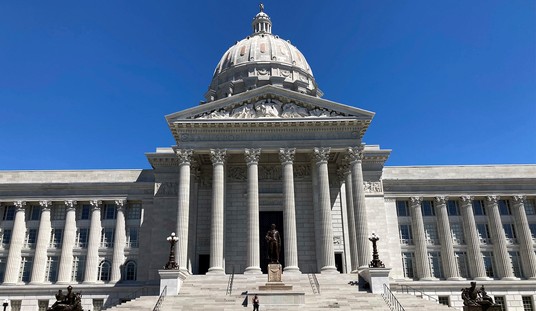=========
=========
Promoted from the diaries by streiff. Promotion does not imply endorsement.
=========
=========
Almost two years ago (July 24th, 2017) I published my first diary here at RedState on the CBO’s estimates of “lost coverage” due to repealing the Obamacare mandate.
At the time, we were in the thick of the battle over how to repeal and replace Obamacare. In the end, the effort would fail, largely due to a complete reversal by the late Sen. John McCain, who had campaigned on repeal a year earlier. In one of the more iconic examples of Republican betrayal in recent memory, Sen. McCain made his way to the front of the floor to give a dramatic thumbs down to the legislation he had previously championed in order to secure his re-election.
While McCain’s vote was the dagger, the CBO was the hand that gave it to him. Their wild, baseless estimates that over 16 million people would lose their insurance if the Obamacare mandate was done away with formed the backbone of all opposition. This narrative was parroted endlessly in the media, by politicians, and was even used to accuse Republicans of causing of people to die as a result.
Bernie Sanders made such claims and then, laugably, received a “Mostly True” rating for the astute, non-biased fact checkers at Politifact.
“What the Republican proposal (in the House) does is throw 23 million Americans off of health insurance,” Sanders told host Chuck Todd. “What a part of Harvard University — the scientists there — determine is when you throw 23 million people off of health insurance, people with cancer, people with heart disease, people with diabetes, thousands of people will die.”
This was, to put it nicely, abject nonsense.
The Republican proposal was never going to throw 23 million people off their health insurance. Such claims were based strictly on CBO estimates that were relying on ridiculous notions, such as the idea that people receiving free healthcare via Medicaid would choose to reject their coverage without a mandate. Does that sound logical to you? We’ll see just how stupid that idea was as we dive into the numbers.
In the end, repealing Obamacare didn’t happen but the mandate itself was done away with in the 2017 GOP tax reform bill. How much of the original 23 million estimate on lost insurance, which ultimately sunk the repeal effort, was based on assumptions about the mandate? The vast majority of it. Over 16 million of the 23 million estimate on lost coverage was blamed on the specific repeal of the mandate.
Avik Roy obtained the baselines from the CBO to show this.
This week, I obtained from a congressional staffer the CBO’s estimates of the coverage impact of repealing the individual mandate, separate from the Senate bill’s other provisions. The estimate was built out of earlier work CBO did to model how repealing the mandate would affect the federal deficit. CBO projected then that repealing the mandate alone would lead to 15 million fewer insured U.S. residents in 2018, and 16 million fewer by 2026, though they did not publish those estimates.
16 million represents nearly three-fourths of the CBO’s estimate of the coverage difference between the GOP bills and Obamacare in 2026.
As I wrote in 2017, the idea that the mandate had any real tangible effect on coverage made little, if any sense at the time.
What does all this mean? First, the repeal of the individual mandate accounts for 73% of all “lost coverage” (which is actually a voluntary decision, but I digress). No matter what the Republicans do, the CBO will assume 16 million less people will be insured because of the repeal of the mandate. Leaving in Obamacare taxes and subsidies (as Senator Graham has suggested) will have no impact. The CBO score is not going to improve. The Republicans are chasing a ghost.
Secondly, the estimate of losses under the mandate should not be taken at face value. The CBO makes many illogical assumptions along the way to get there. These include the idea that people will turn down subsidies, drop coverage they need, and in some cases even turn down nearly (or completely) free healthcare just because the government no longer requires coverage. It also assumes that most of the previous coverage gains were not because of subsidies or expanding Medicaid, but rather, because of the power of the mandate. All of this makes little sense in relation to the actual details of the provision, which include penalties so low as to do almost nothing to incentivize getting coverage.
Aside from the garbage estimates on the mandate, the CBO was also using outdated and provably wrong estimates about future coverage to score against.
The problems don’t stop there, with the CBO making perhaps an even more egregious misrepresentation. While enrollment in 2017 is just 10.3 million people, the CBO’s updated projections say that 18 million will enroll by 2018 with a peak of 19 million the next year. That projection is what they are using to compare to the AHCA, BCRA, and a full repeal. Yes, the CBO is scoring the Republican bill(s) against the assumption that Obamacare enrollment will go up nearly 100% in the next year. Possible? Hardly. Obamacare’s enrollment has actually been flat-lining for years. There is zero evidence nor logic to the idea that Obamacare will nearly double it’s participants by 2018. Yet, the CBO decided to use that as their baseline anyway. That factor alone should disqualify their analysis.
In the end, this led to wildly false proclamations about Republicans throwing tens of millions off their insurance when in reality, the actual difference between the ACA (Obamacare) and the BCRA (Republican repeal/replace bill) was a few million at best. I said as much at the time.
When you put all this together, the actual difference between the Republican bills and Obamacare is a few million at best. The CBO places completely unrealistic faith in the power of the individual mandate, even as they’ve been proven wrong by large margins every preceding year regarding it.
Two years later, those of us who sought to challenge the prevailing narrative have been largely vindicated. The individual mandate was repealed in December of 2017 via the tax bill and these are the results. Per the Washington Examiner (because no mainstream outlet is going to touch this).
In what was literally a footnote in its annual report on national health spending projections, actuaries for the Centers for Medicare and Medicaid Services on Wednesday estimated that the elimination of the individual mandate would have a significantly smaller impact than the CBO has long estimated. Specifically, the CMS report revealed that 2.5 million more people would go without insurance in 2019 due to the repeal of the individual mandate’s penalties, and the impact would be “smaller” thereafter.
This falls almost exactly inline with the projections I shared in my original 2017 piece. Instead of 16 million more people being uninsured by 2018 due to the loss of the mandate, only 2.5 million were. Those 2.5 million also did not “lose” their insurance, as often claimed by Democrats and media members. They made the free choice to go without. Even then, I’m skeptical of trusting anything the CBO says at this point. The actual number could be zero for all we know.
Furthermore, the CBO’s completely irrational assumptions about Medicaid (that 5 million would give it up) turned out to be 100% false. This is per the report linked by the Washington Examiner.
“By 2019 the individual mandate repeal is anticipated to result in about 1.5 million fewer direct-purchase-market enrollees, who are expected to be somewhat younger and healthier than those who retain coverage, as well as about 1.0 million fewer employer-sponsored-insurance-market enrollees, than otherwise would have been projected. After 2019 the enrollment effects are expected to be smaller. Medicaid enrollment is assumed to be unaffected.”
Two years ago the CBO was shouting that 5 million would lose coverage on Medicaid over the loss of the mandate. Today, they say it’s been “unaffected.”
Lastly, notice the second to last sentence. They say that enrollment effects are expected to be smaller in the future. This is the exact opposite of what they said in 2017, where they projected huge increases in the uninsured via enrollment spanning all the way to 2027.
In the end, Obamacare remains largely intact today because the CBO’s (now provably false) estimates provided cover for Democrats to trash the repeal and replace effort. It also served as a battering ram to beat moderate Republicans into submission. Without the CBO estimates, would John McCain have given the thumbs down? I can’t say for sure but given how much it appeared to play into his thinking at the time, the answer is likely no.
The CBO should not have this much power. Over the decades, it’s hard to find a single bill the CBO has scored correctly, much less all it’s machinations around Obamacare. The idea that the career bureaucrats who make these reports are non-partisan is questionable at best and given how wrong they continually are, they serve no real purpose but to negatively muddy the waters around policy discussions.
The entire direction of American healthcare was altered due a non-elected body putting out numbers that were completely baseless and illogical. That’s not hindsight either, as I and many others were pointing out all the issues at the time. Currently, we are firmly on a path to socialized medicine because the moment to pull back what Obamacare did has now passed. All of this because of some bogus numbers from the CBO.
The next time you hear the media cite the CBO as a reason to oppose a GOP initiative, remember this episode. The deserve not one ounce of credibility after this.














Join the conversation as a VIP Member